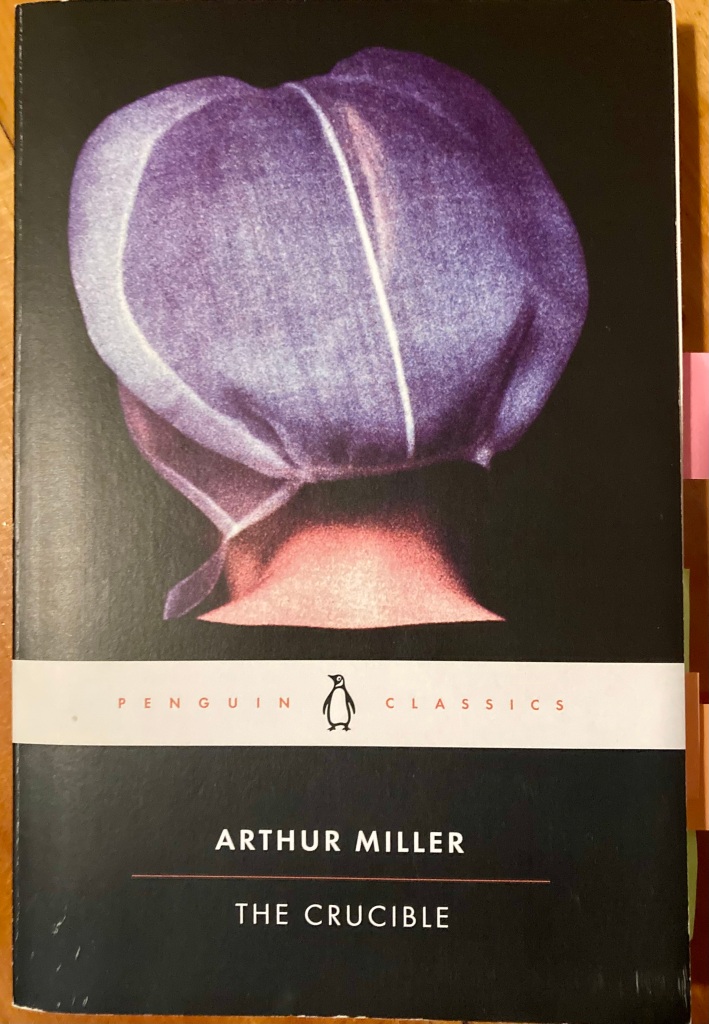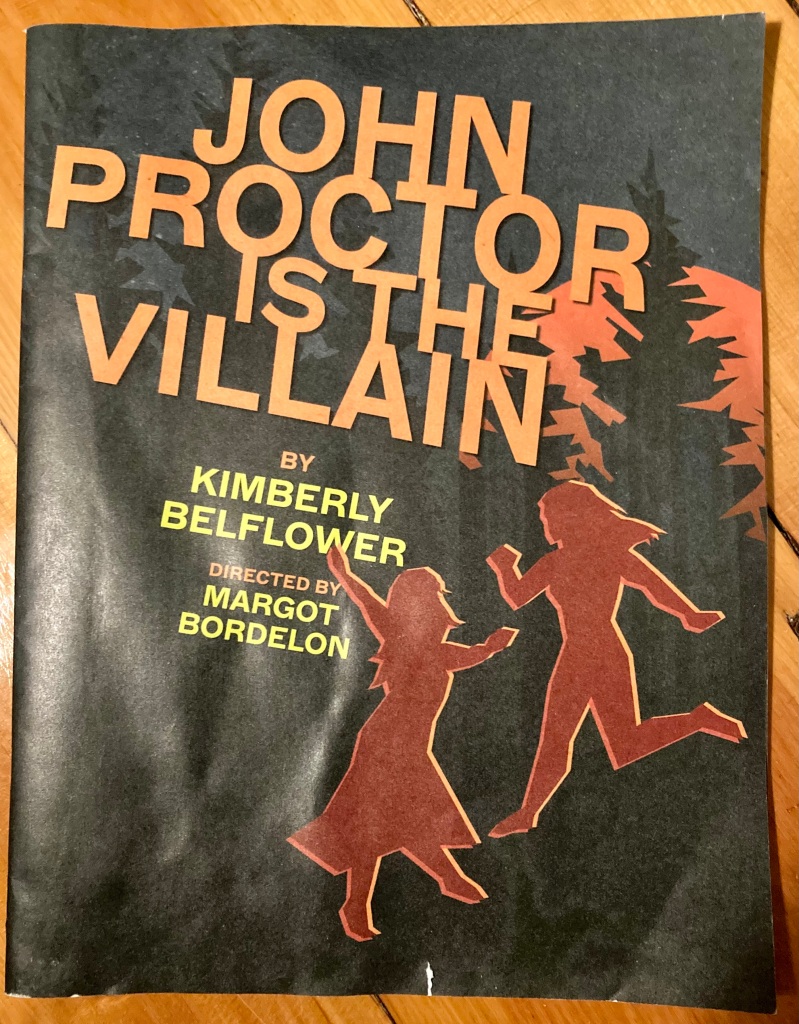A reflection on: John Proctor is the Villain
Growing up, English classes were usually my favorites, particularly in high school. In high school I had amazing teachers who made texts come alive for us by helping us see the context of their authors and some of their motivations. I clearly remember the excitement I felt in learning to contextualize and analyze what I was reading, including the symbols and hidden meanings in the poem “Rime of the Ancient Mariner” and the social commentary by Henry David Thoreau in Walden.

Also on that list? The Crucible, by playwright Arthur Miller. I had never gotten as excited about a play before I read The Crucible. The Crucible is set during the witch trials of 1692 and is written as a commentary on the 1950s McCarthy era “witch hunts.” Like many 15 year olds I was irked by the fact that in the play neighbors who knew each other well were falsely accusing one another of crimes. The injustice usually hits readers first, I’ve noticed, the first time they read the play.
But the second reaction I had to the play was one of (teenage) moral outrage – how could the main character, John Proctor, decide to plead innocent to witchcraft when he knew pleading guilty would have saved his life? Wasn’t he a husband? A dad? Wouldn’t his family better off with him alive? I was pissed. I wrote my first truly passionate high school essay about The Crucible.
Time passed. I took many more excellent literature courses in college. I had strong feelings and passionately worded essays about other plays and novels. And then, many moons later, I became a Salem walking tour guide. And guess what text most of the American guests on my tour associate with the witch trials? The Crucible. I’ve also met many folks who understandably remember The Crucible as an historical account of the witch trials rather than a work of fiction.
It’s understandable because even though the Salem Witch Trials are taught in public schools, it’s one event of many during many years of school. As time passes and life goes on it’s no wonder some people conflate their high school English experience of the play with the history they learned in middle school. Plus, all the names of the characters were real people. Arthur Miller came here in 1952 and read the trial documents – he did his homework.
But The Crucible is not an historic account. Main character/temptress/afflicted girl Abigail Williams was not 17 in 1692, she was 12, and no (please don’t be alarmed) there was no sexual relationship between her and 60ish-year-old John Proctor. The adultery added another layer of complexity to the relationships between the characters in the play, and importantly, John Proctor’s relationship to himself. Proctor’s guilty conscience is basically another character in the play, just as Daniel Day Lewis’s bare chest is another character in the 1996 film version also starring Winona Ryder and Joan Allen (a story for another time).
Newly interested by the play after hearing so many tour guests mention it, I read it, this time 25ish years and a lot more life experience later. I was mildly surprised to discover that I loved it. Miller’s play was more understandable to me as an adult, especially the reasons why Proctor’s “good name” should be so precious to him to give his life for it. But there was another surprise: I wasn’t nearly so interested in John Proctor as I was in Abigail and in Elizabeth Proctor. They were two women unwillingly caught in a love triangle and they had some amazing scenes!
You know what else I noticed? John Proctor had reason to not feel so good about himself – he didn’t treat either of those women with respect. When I had my own tour company a couple years ago, I spent about a year offering a Crucible tour, which took folks through the city explaining the context of Salem in 1692 and then ended at the Salem Athenaeum for a book group. It was really fun. Not insanely popular because, let’s be honest, it was a tour that gave guests a reading assignment before they showed up. But the people who came were amazing and we had some fascinating conversations. I’ll never forget one conversation that included a woman who grew up in Ireland during The Troubles. Some of the parallels between The Troubles and 1692 about neighbors turning against neighbors were ones I’d never considered.
I also noticed in discussions with guests that some of them were really interested in Abigail and Elizabeth too. Abigail is brave enough to stand up for herself in front of the head judge, for heavens sake: “Let you beware, Mr. Danforth. Think you to be so mighty that the power of Hell may not turn your wits?” (Act 3 p. 100) And at the end of the play Proctor gives his wife Elizabeth power over his own life, asking her what he should tell the judges. These are women with some life and death decisions on their hands, and regarding a man who has wronged them both.

Fast forward to about a month ago, and somewhere on the magic internet I saw the title of a play in Boston that caught my eye: John Proctor is the Villain. No matter your opinion on The Crucible, you have to admit that’s a solid title. Playwright Kimberly Belflower wrote John Proctor while the Me Too movement was becoming headline news. She, too, reread The Crucible as an adult, and remembered being taught that John Proctor was the hero. She, too, remembered feeling confused by the play’s ending as a young person, and as she finished reading it as an adult, she relates, “I found myself saying out loud, ‘John Proctor is the villain.’” (quoted in the program)
Her play, which is being beautifully performed at the Huntington in Boston, is set in 2018 in a small rural town where the sophomore English class is reading The Crucible. During the play the issue of sexual misconduct impacts the lives of the characters as does adolescence, strong emotions, growing pains, and friendship. Despite the play’s title a variety of viewpoints on the role of John Proctor in The Crucible is represented, which makes the characters’ discussions, alliances and disagreements all the more relatable and poignant.
I’ve already included spoilers for The Crucible in this post so I don’t want to give too much away about Belflower’s play, as I hope interested folks will go see it. I will say the Boston cast does an amazing job of inhabiting their characters and making the story come to life. The Me Too-era music is a great audible backdrop for the story. I’ll also say I cried during the final scene and felt something shift in my core as I saw fictional young women reinterpret the meaning of an earlier play so (seemingly) familiar to current and aging high school kids in the US. Using a 1953 text, these young characters dare to reimagine heroism for the 21st century.
The last scene of Belflower’s play felt like an exhale, a beautiful coda to a years-long conversation between me and The Crucible. It’s not really the coda though, because I’m still going to be reading and interpreting The Crucible in the years to come. Why? I still love the play. And though I look forward to future conversations to unpack the complexities of the play’s female main characters, I haven’t dismissed John Proctor. He’s not, and never was the hero in my reading of the play, but he has some great moments of introspection. He utters one of my favorite lines in the play, as relatable in the context of 1692 as it was in 1953 and still today, addressing the concept of the “crucible” itself as an intense moment which strips those involved of all their masks and pretense: “It is a providence, and no great change; we are only what we always were, but naked now.” (Act 2, p. 26)
In the span of an entire life no one, real or fictional is only a hero or only a villain. In moments – particularly crucible moments – we can embody one or the other. In those moments, if we’re lucky, we notice when we’re being heroic or villainous and we learn from it. This, to me, is why The Crucible is still a relevant text, why John Proctor, Abigail Williams, and Elizabeth Proctor are so relevant, and yes, even why the Salem Witch Trials are still relevant over 300 years later. The hero & the villain and everything in between are in each one of us. The question is, at any given moment, which one are we choosing to give life to?
Arthur Miller, The Crucible (New York: Penguin Classics, 2003).